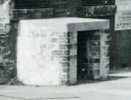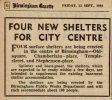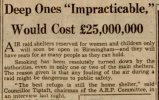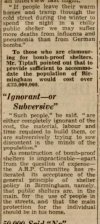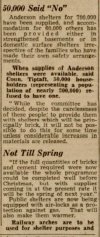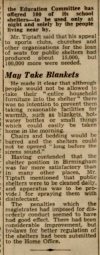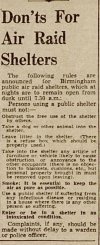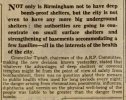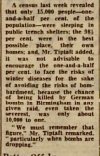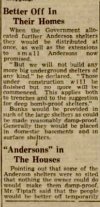-
Welcome to this forum . We are a worldwide group with a common interest in Birmingham and its history. While here, please follow a few simple rules. We ask that you respect other members, thank those who have helped you and please keep your contributions on-topic with the thread.
We do hope you enjoy your visit. BHF Admin Team
You are using an out of date browser. It may not display this or other websites correctly.
You should upgrade or use an alternative browser.
You should upgrade or use an alternative browser.
Air raid shelters
- Thread starter Peter Walker
- Start date
its ok mike...just goes to show they are still out thereYes Janice you are right. Was confused by the fact that the report had todays date on top. The date of the actual report was lower down in smaller type
lyn
pjmburns
master brummie
If you Google it then loads of finds seem to come up.
It wouldn't surprise me if there was one at the bottom of our garden. Now going underneath the fence with next door. Probably for our terrace ofv4 cottages. When you dig you hit something pretty solid but would have to remove a lot of established shrubs.
It wouldn't surprise me if there was one at the bottom of our garden. Now going underneath the fence with next door. Probably for our terrace ofv4 cottages. When you dig you hit something pretty solid but would have to remove a lot of established shrubs.
ok jan get moving those shrubs thenIf you Google it then loads of finds seem to come up.
It wouldn't surprise me if there was one at the bottom of our garden. Now going underneath the fence with next door. Probably for our terrace ofv4 cottages. When you dig you hit something pretty solid but would have to remove a lot of established shrubs.
rosie
brummie
I have mentioned before that the previous owner of our house was a builder and filled the air-raid shelter with rubble. I did try to remove some of it years ago but it's still full. There were a few things down there including a wooden chest, I thoght I had found treasure but it was full of bricks! Recently the grandchildren had a look but it's not safe to go down anymore.
rosie.
rosie.
www.midlandspubs.co.uk
Pub Historian
www.midlandspubs.co.uk
Pub Historian
usually seen at the front of houses and i think but only think they were exits from the cellars should one get trapped during ww2 bombings..think ive read it somewhere also think they were bigger than they look
lyn.
Sounds feasible Lyn, a way out of the cellar perhaps.
exactly kieron i have read of cellars flooding when houses took a direct hit and sadly people drowned...of course not all houses had them..until about 15 years ago there as still evidence of one in smith st hockley minus the old house of course..i went back few years ago to take a photo of it but it had goneSounds feasible Lyn, a way out of the cellar perhaps.
lyn
www.midlandspubs.co.uk
Pub Historian
exactly kieron i have read of cellars flooding when houses took a direct hit and sadly people drowned...of course not all houses had them..until about 15 years ago there as still evidence of one in smith st hockley minus the old house of course..i went back few years ago to take a photo of it but it had gone
lyn
I haven't got a cellar, only a sub-level pantry - looks like I'll be fried when the impending bomb lands on my roof.
www.midlandspubs.co.uk
Pub Historian
Some cellars might have had coal hole entrances to the cellars, which would have acted as an emergency exit , but would need protecting from debris if area was bombed. Just a supposition
Cheers Mike, I think you and Lyn have nailed it.
Our house in Gladys Road Bearwood had the remains of an Anderson Shelter in the garden. We used it as a cold frame. My parents lived in Ladywood during the war. Neighbours told me that Thimblemill Baths had a deep shelter with an exit over the road in Mill Gardens. There are some pictures on https://www.subbrit.org.uk/sites/smethwick-baths-air-raid-shelter/ In nearby Beakes Road was an American stores base though no sign of it remained by the early 1960s. USAAF Station 522.
Last edited:
These were indeed covers over entrances to cellars. During the war there were a number of them in Birmingham city centre. I remember one particular one outside C&A. The reason for this is that just after the war the King & Queen visited Birmingham and Mom and I went to see them. To get a better view I stood on the one outside C&A, which was great. However when I come to get down I fell, bashing my head against the shop window almost knocking myself out.
Makes sense. I was always amazed when the sun had been on the house all-day how well the bricks retained the heat. I think they used to be inside electric storage heaters too.
Richard Dye
master brummie
Interesting statistic 10,000 to 1. My parents home was bombed as were many in Aston. It was a difficult time but even more so for Aston and other areas.No more big underground dugouts…Germs Worse Than Bombs.
(Birmingham Gazette November 1940)
View attachment 190792View attachment 190793View attachment 190794
Radiorails
master brummie

Norman Tiptaft - Wikipedia
i was just thinking how not that many years after the war us kids used to play for hours in the brick built above ground air raid shelters in villa street and of course never realising just what they were built for and how scared people must have been if they had to use them because although a bit safer than staying in the house air raid shelters were hit and many lost their lives in them
lyn
66 Barker Street, Lozells West Midlands Police Records Raid 25 - 26th/27th October 1940 Air Raid Warning Red was received at 7.11 p.m. on Saturday 26th and the White message was sound at 12.20 a.m. The first report of a bomb being dropped was at 8.7 p.m. Approximately 138 High Explosive bombs were dropped, 17 of these were reported unexploded. Incendiary bombs were also dropped and caused 114 incidents. The districts chiefly affected were: City Centre, Highgate, Balsall Heath, Hockley, Lozells, Aston and Ladywood. About 50 factories were damaged including the following key points: Fisher and Ludlow, Clyde Street - High Explosive; Newey Brothers, Brearley Street - High Explosive, slight damage; Webley and Scott, Slaney Street - Incendiary bomb - slight damage; Belliss and Morcom Limited - Delayed Action bomb; Archdales, Icknield Street - High Explosive, 2 fatal casualties; Bulpitts, Camden Street - gutted by fire; Strattons, Bromsgrove Street - damaged by fire. Serious fires broke out in the following regions: Constitution Hill and Henrietta Street; Great Charles Street, Newhall Street, Edmund Street; LMS Goods Yard, Suffolk Street and surrounding premises. One AFS man is reported killed at the latter incident. Total casualties - 118 fatal and 90 non-fatal. Direct hits by High Explosive on shelters accounted for many casualties. Barker Street and Villa Street - 16 fatal and 23 non-fatal; Witton Road - 11 fatal. Kent Street Baths, a First Aid Post, was hit by a High Explosive and the casualties were 3 fatal and 10 non-fatal. Police War Reserve, Hodgetts, C Division, was killed at the incident at Bullpits, Camden Street. Other damage: A Division - Whittall Street, Kent Street, City Arcade, Bristol Street, Town Hall, GPO, Council House; B Division -Sheepcote Street, Wellington road, Broad Street. C Division - Hockley Hill, Summer Lane, Farm Street. D Division - Newtown Row. E Division - Cannon Hill.
lyn
66 Barker Street, Lozells West Midlands Police Records Raid 25 - 26th/27th October 1940 Air Raid Warning Red was received at 7.11 p.m. on Saturday 26th and the White message was sound at 12.20 a.m. The first report of a bomb being dropped was at 8.7 p.m. Approximately 138 High Explosive bombs were dropped, 17 of these were reported unexploded. Incendiary bombs were also dropped and caused 114 incidents. The districts chiefly affected were: City Centre, Highgate, Balsall Heath, Hockley, Lozells, Aston and Ladywood. About 50 factories were damaged including the following key points: Fisher and Ludlow, Clyde Street - High Explosive; Newey Brothers, Brearley Street - High Explosive, slight damage; Webley and Scott, Slaney Street - Incendiary bomb - slight damage; Belliss and Morcom Limited - Delayed Action bomb; Archdales, Icknield Street - High Explosive, 2 fatal casualties; Bulpitts, Camden Street - gutted by fire; Strattons, Bromsgrove Street - damaged by fire. Serious fires broke out in the following regions: Constitution Hill and Henrietta Street; Great Charles Street, Newhall Street, Edmund Street; LMS Goods Yard, Suffolk Street and surrounding premises. One AFS man is reported killed at the latter incident. Total casualties - 118 fatal and 90 non-fatal. Direct hits by High Explosive on shelters accounted for many casualties. Barker Street and Villa Street - 16 fatal and 23 non-fatal; Witton Road - 11 fatal. Kent Street Baths, a First Aid Post, was hit by a High Explosive and the casualties were 3 fatal and 10 non-fatal. Police War Reserve, Hodgetts, C Division, was killed at the incident at Bullpits, Camden Street. Other damage: A Division - Whittall Street, Kent Street, City Arcade, Bristol Street, Town Hall, GPO, Council House; B Division -Sheepcote Street, Wellington road, Broad Street. C Division - Hockley Hill, Summer Lane, Farm Street. D Division - Newtown Row. E Division - Cannon Hill.
Richard Dye
master brummie
i was just thinking how not that many years after the war us kids used to play for hours in the brick built above ground air raid shelters in villa street and of course never realising just what they were built for and how scared people must have been if they had to use them because although a bit safer than staying in the house air raid shelters were hit and many lost their lives in them
lyn
66 Barker Street, Lozells West Midlands Police Records Raid 25 - 26th/27th October 1940 Air Raid Warning Red was received at 7.11 p.m. on Saturday 26th and the White message was sound at 12.20 a.m. The first report of a bomb being dropped was at 8.7 p.m. Approximately 138 High Explosive bombs were dropped, 17 of these were reported unexploded. Incendiary bombs were also dropped and caused 114 incidents. The districts chiefly affected were: City Centre, Highgate, Balsall Heath, Hockley, Lozells, Aston and Ladywood. About 50 factories were damaged including the following key points: Fisher and Ludlow, Clyde Street - High Explosive; Newey Brothers, Brearley Street - High Explosive, slight damage; Webley and Scott, Slaney Street - Incendiary bomb - slight damage; Belliss and Morcom Limited - Delayed Action bomb; Archdales, Icknield Street - High Explosive, 2 fatal casualties; Bulpitts, Camden Street - gutted by fire; Strattons, Bromsgrove Street - damaged by fire. Serious fires broke out in the following regions: Constitution Hill and Henrietta Street; Great Charles Street, Newhall Street, Edmund Street; LMS Goods Yard, Suffolk Street and surrounding premises. One AFS man is reported killed at the latter incident. Total casualties - 118 fatal and 90 non-fatal. Direct hits by High Explosive on shelters accounted for many casualties. Barker Street and Villa Street - 16 fatal and 23 non-fatal; Witton Road - 11 fatal. Kent Street Baths, a First Aid Post, was hit by a High Explosive and the casualties were 3 fatal and 10 non-fatal. Police War Reserve, Hodgetts, C Division, was killed at the incident at Bullpits, Camden Street. Other damage: A Division - Whittall Street, Kent Street, City Arcade, Bristol Street, Town Hall, GPO, Council House; B Division -Sheepcote Street, Wellington road, Broad Street. C Division - Hockley Hill, Summer Lane, Farm Street. D Division - Newtown Row. E Division - Cannon Hill.
We never played in those air raid shelters but we did play in bombed out buildings. We became pretty good at cleaning up the bricks and build goodness knows what with them. I had a friend who lived over the PDSA at the junction of Soho and Hamstead Roads. Behind the PDSA was a bombed building that we built a one room den in out of bricks, with its own fireplace and chimney.i was just thinking how not that many years after the war us kids used to play for hours in the brick built above ground air raid shelters in villa street and of course never realising just what they were built for and how scared people must have been if they had to use them because although a bit safer than staying in the house air raid shelters were hit and many lost their lives in them
lyn
66 Barker Street, Lozells West Midlands Police Records Raid 25 - 26th/27th October 1940 Air Raid Warning Red was received at 7.11 p.m. on Saturday 26th and the White message was sound at 12.20 a.m. The first report of a bomb being dropped was at 8.7 p.m. Approximately 138 High Explosive bombs were dropped, 17 of these were reported unexploded. Incendiary bombs were also dropped and caused 114 incidents. The districts chiefly affected were: City Centre, Highgate, Balsall Heath, Hockley, Lozells, Aston and Ladywood. About 50 factories were damaged including the following key points: Fisher and Ludlow, Clyde Street - High Explosive; Newey Brothers, Brearley Street - High Explosive, slight damage; Webley and Scott, Slaney Street - Incendiary bomb - slight damage; Belliss and Morcom Limited - Delayed Action bomb; Archdales, Icknield Street - High Explosive, 2 fatal casualties; Bulpitts, Camden Street - gutted by fire; Strattons, Bromsgrove Street - damaged by fire. Serious fires broke out in the following regions: Constitution Hill and Henrietta Street; Great Charles Street, Newhall Street, Edmund Street; LMS Goods Yard, Suffolk Street and surrounding premises. One AFS man is reported killed at the latter incident. Total casualties - 118 fatal and 90 non-fatal. Direct hits by High Explosive on shelters accounted for many casualties. Barker Street and Villa Street - 16 fatal and 23 non-fatal; Witton Road - 11 fatal. Kent Street Baths, a First Aid Post, was hit by a High Explosive and the casualties were 3 fatal and 10 non-fatal. Police War Reserve, Hodgetts, C Division, was killed at the incident at Bullpits, Camden Street. Other damage: A Division - Whittall Street, Kent Street, City Arcade, Bristol Street, Town Hall, GPO, Council House; B Division -Sheepcote Street, Wellington road, Broad Street. C Division - Hockley Hill, Summer Lane, Farm Street. D Division - Newtown Row. E Division - Cannon Hill.
Not thinking at all about how the building got that way or what happened to the people in it.
we were only innocent children then richard its amazing how we made our own entertainment from very littleWe never played in those air raid shelters but we did play in bombed out buildings. We became pretty good at cleaning up the bricks and build goodness knows what with them. I had a friend who lived over the PDSA at the junction of Soho and Hamstead Roads. Behind the PDSA was a bombed building that we built a one room den in out of bricks, with its own fireplace and chimney.
Not thinking at all about how the building got that way or what happened to the people in it.
lyn
D
Deleted member 118921
Guest
I have an old book written by Tiptaft.Seeing the name of Cllr. Tiptaft reminded me that I remembered him, in my youth, but as an Alderman.
Norman Tiptaft - Wikipedia
en.wikipedia.org

